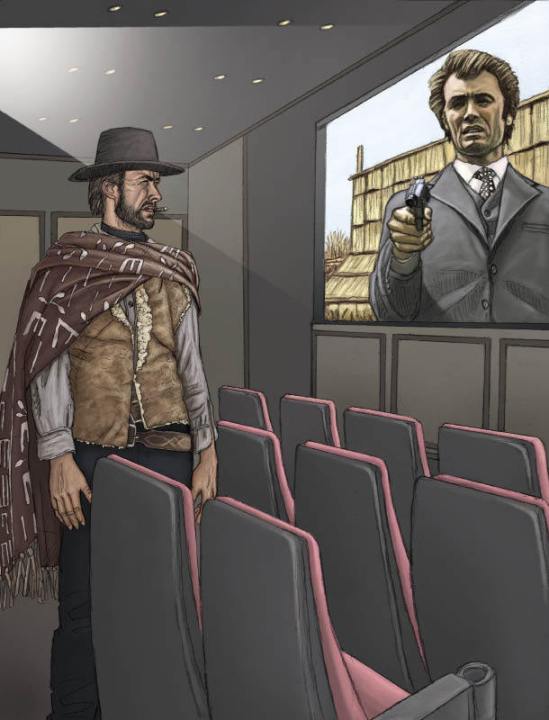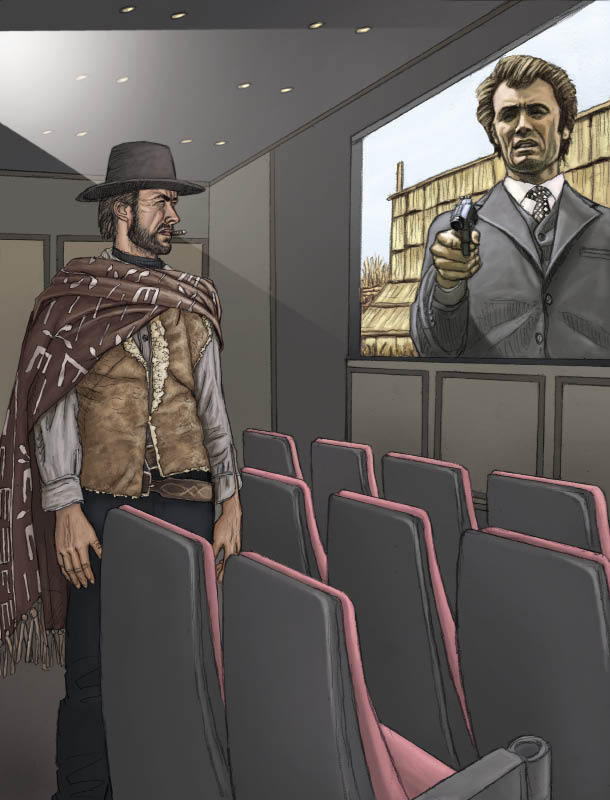As Clint Eastwood celebrates his 80th birthday, Peter Hoskin salutes his artistic legacy
My life at the movies began with Clint Eastwood about a decade ago. Channel 4 was screening A Fistful of Dollars (1964) one night, and my brother insisted that we stay up and tune in. I didn’t know beforehand that it was a western, let alone one directed by the great Sergio Leone. But, from the opening scene, I knew everything I needed to know about Clint: the poncho, the cheroot, those eyes burning with cathode ray intensity. This, I realised, is what people meant when they talked about cinema. And I was hooked.
Fast forward to the present, and the lone gunslinger is about to turn 80 years old. He still stands tall, lean and gruff, with none of that old intensity dimmed by the passage of time. And I still regularly watch A Fistful of Dollars and its sequels, For a Few Dollars More (1965) and The Good, the Bad and the Ugly (1966), to remind myself of just how red-blooded the movies can be. This trilogy introduced me not just to Clint’s indelible Man With No Name character, but also to a useful rule of thumb: Clint Eastwood always fills the screen.
This rule certainly holds firm in Dirty Harry (1971), which provided Eastwood with his second defining role. Inspector Harry Callahan is both irresistible force and immovable object — discharging his righteous fury and .44 Magnum on the criminals of San Francisco, while standing stubborn in the face of city bureaucracy. The critic Pauline Kael famously described the film as ‘fascist’, more or less for these reasons. But, either way, it cemented Clint’s status as a masculine ideal. A man who follows no moral code but his own. A rebel with a cause.
So, by the early 1970s, Eastwood already had two iconic characters under his belt, and had proved himself as the most popular cowboy since John Wayne and the most muscular leading man since Robert Mitchum. Not bad going for someone who had bounced around between the army, uncredited film roles and television until the age of 35. But Clint wasn’t prepared to wallow in his new-found success. Instead, he began to do something that was extraordinary and risky in equal measures. He began to deconstruct his own myth.
This process took a number of forms, spread over many years — but the first readable tremors came from Eastwood’s directorial debut, Play Misty for Me (1971). This was an unexpectedly low-key number, in which a sexual encounter between a DJ (Eastwood) and a crazed fan (Jessica Walter) collapses into a dangerous, obsessive spiral. Gone is the ‘Bang, you’re dead!’ outlook of Clint’s earlier work, replaced with stabbings, suicide attempts and psychological trauma. The final scene, in which Eastwood shoves Walter out of a window, feels like a jolt from a cattle prod.
And there were sharp turns and curious meanderings elsewhere. The second Dirty Harry film, Magnum Force (1975), is an open-minded response to the strident vigilantism of the first. Around it, Eastwood directed a pair of westerns, High Plains Drifter (1973) and The Outlaw Josey Wales (1975), which are considerably more elegiac and eccentric than his work with Leone. And, as the 1980s drifted into view, he even co-starred in a couple of films with an orangutan. They were comedies, in case you were wondering.
Even politically, Eastwood has long since cut loose from the labels and lazy preconceptions that stifle so many of his contemporaries. This one-time Mayor of Carmel is ostensibly a Republican, but he has funded and supported Democrats in California. And he has put his name behind such wide-ranging causes as gay marriage, mortgage support, electric cars and equal rights for women. When pressed on the matter, Clint will only describe himself, wearily, as a ‘libertarian’.
All is preamble, though, for what remains Eastwood’s greatest achievement as an actor and as a director — 1992’s Unforgiven. A western populated by grey-haired men, it asks, as no other had before it, what is the true cost of killing and of dying? And the answers are carved into the faces, and loaded on to the shoulders, of the film’s main characters. Here, no death is treated casually, and no gun is fired without grim repercussions for the man who pulled the trigger. It is as though Clint is atoning, perhaps apologising, for the flippant violence of Dirty Harry and The Man With No Name.
Unforgiven is much more than just a text on Eastwood’s career, though. Take the scene where Little Bill (Gene Hackman) reveals English Bob’s (Richard Harris’s) tales of derring-do for what they are: a lie designed to brush over a trail of drunken brawls, clumsy misses and murderous cowardice. Watching it now, this feels like just as much an attack on America, and how it has chosen to ignore its turbulent past, as on the storytellers of Hollywood. Myth, sadly, has become an opiate for the masses — a theme that Eastwood would develop in his recent masterwork, Flags of our Fathers (2006).
Even around the time of Unforgiven, we could marvel at Eastwood’s relentlessness and vigour — the film won him his first two Oscars, for Best Picture and Best Director, at the age of 62. Now, though, 18 years and two more Academy Awards later, his longevity is nothing short of remarkable. Still broad-shouldered and energetic, Clint has confronted his senior status head-on in films such as In the Line of Fire (1993), Million Dollar Baby (2004) and Gran Torino (2009). The white hair and wrinkles have become props, not hindrances.
But the main reason why Clint persists is simply that he still has a lot to say, and fresh ways in which to say it. Who watching Where Eagles Dare in 1968 would have thought Eastwood would go on to make a film depicting the second world war through Japanese eyes? Who, even ten years ago, would have predicted that he would make films with strong female leads? But he has achieved all this, and more. And, with two more films currently in development, you have to hope that the self-renewal and introspection continue apace. Cinema is richer for it.
As the American novelist Theodore Dreiser once said, ‘True art speaks plainly.’ And speaking plainly is what Eastwood has been doing, in his acting, his politics, his film-making and the way he has lived his life, for the best part of 80 years now. The result is an artistic legacy that is as honest, and as American, as we could wish for. So let us speak plainly in response: Happy Birthday, Clint — and thanks.







Comments